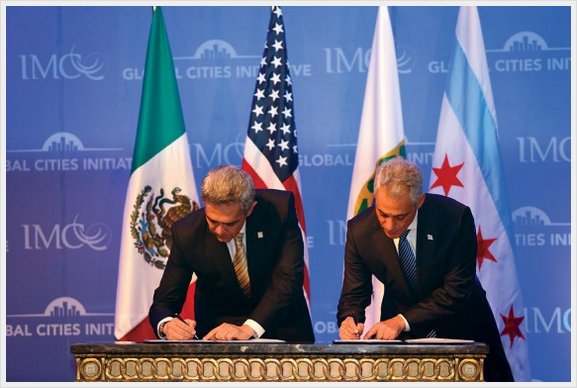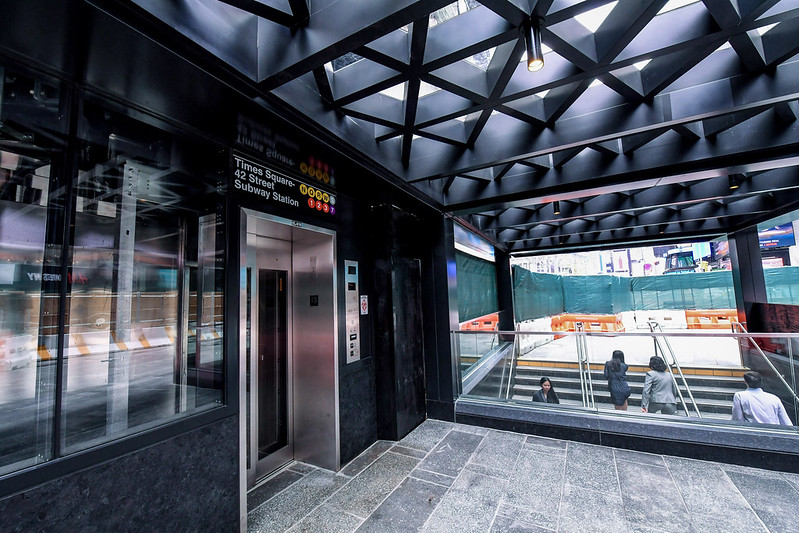
Photo: Chicago-SCI
How sister city partnerships can play a new role in a global economy
27 May 2014
by Richard Forster
The concept of twin towns and sister cities was conceived after the Second World War to rebuild diplomatic relationships and reconcile citizens through cultural and educational exchanges. But in the modern era, Jonathan Ballantine reveals how sister city partnerships are being increasingly used to forge strategic trade and economic ties
Most UK visitors to France have seen the sign when you get off the ferry telling you that Boulogne is twinned with Folkestone in the UK, La Plata in Argentina and Zweibrücken in Germany but beyond providing gems of trivia such as the distance needed to reach the twin city, is there really a role for sister cities in a modern, global, digital economy?
As well as claiming that sister city relationships do not benefit the cities involved, detractors say that the programmes are only used by elected officials to justify expensive overseas travel or to gain political support within a community.
In the 1950s and 1960s, there was a clear purpose for sister city partnerships– the world was emerging from the chaos and destruction of the Second World War and there was a need for peace, reconciliation and diplomacy through educational and cultural linkages. Remember also this was a time of limited communication, travel and immigration and most people only focused on their local community, while anything else was viewed as foreign (read alien) and therefore not to be trusted. “Since our creation in 1951, our main aim has consisted in helping citizens to reconcile after the war through town twinning partnerships,” says Georgina Mombo, Press Officer at the Council of European Municipalities and Regions in Brussels.
Today we live in a world where people can communicate, travel and migrate to all corners of the world and increasingly, the citizens of major cities such as London, New York and Tokyo have more in common with each other than with people from rural areas.
While sister city relationships have traditionally been developed for diplomatic, cultural or educational purposes, in today’s economic climate there is a growing need for cities to expand and leverage sister city partnerships for economic development.
“For the last 20 years we have been working to go beyond cultural and symbolic partnerships, by promoting modernised partnerships serving as a tool for municipalities and towns to face mutual issues: economic development, water management, waste recycling, the improvement of social services or language exchanges,” adds Mombo.

Adam Kaplan, Membership Director at Sister Cities International in Washington DC, says that in late 2009 a number of members were not renewing their membership in an effort to cut public spending but that over the last two years, the same cities were now coming back and asking Sister Cities International how their sister city relationships could be expanded. “Over the last five years there has been significant interest from our members as to how these partnerships can be expanded towards economic development,” says Kaplan.
Building trust is often cited as a key component in business decisions and according to Shahrzad (Sherry) Dowlatshahi, Head of International Relations in the US city of San Antonio, the sister city relationship sets the foundation for diverse participants from each city to come together to promote engagement and mutual understanding. And this includes companies. There are now over 30 Japanese companies investing in San Antonio including Toyota Motors.
“We have a 26 year-old relationship with Kumamoto of Japan which has enabled us to build mutual trust between the two cities–a vital ingredient for successful business development,” says Dowlatshahi. “The [Japanese] companies contribute significantly to our local economy through job creation and increased productivity.”
Cities driving world economy
It is clear that cities operate and compete in a different world today than they did 50 years ago. By 2030, it is projected that the global urban population will reach 75 percent, and over 90 percent of global GDP will result from urban activity. According to research by McKinsey, one-third of the world’s GDP will come from just 100 cities. At the heart of this change is globalisation which is increasing trade flows between regions, and is shifting economic power towards the emerging economies of China and India, or more accurately, the cities of these regions. “It’s cities and not nations that are driving the global economy, and are the engines for growth through productivity, innovation and job creation”, says David Adam, Founder of Global Cities which provides strategic advice to cities on positioning, branding and investment opportunities.
Cities were born because merchants gathered to sell spices, silks, and teas. Cities, not nations, enhanced trade by providing the physical space, constant interaction, and economic specialisation needed to facilitate exchange between previously isolated actors.
In 2012, Brookings and JPMorgan Chase launched the Global Cities Initiative (GCI), aimed at helping US cities strengthen their regional economies by becoming more competitive in the global marketplace. “We believe that cities need to get back to their roots, which is to be centres of trade and commerce,” says Amy Liu, senior fellow, and co-director of the Brookings Metropolitan Policy Program.
To support this aim, GCI publishes a regular Global MetroMonitor, which tracks the economic performance of the 300 largest world cities. The monitor revealed that 75 percent of the fastest- growing metropolitan economies in 2012 were from developing regions, and that metro areas outperformed their countries on employment growth in 2012.
Global economic factors such as globalisation and urbanisation are opening up new markets, intensifying competition and adding new layers of complexity to global supply chains. Therefore it is critical for city leaders to understand how global economic factors can affect the competitiveness of their city and determine how their unique assets can service the impacts of globalisation so that they can become beneficiaries of new trade flows, direct investment, job creation and innovation and remain an attractive proposition in a world economy.
“We are now living in the Urban Age and cities are the most important unit of social and economic reproduction because they supply the most important component in today’s globally connected economic system: people,” says Adam.
By leveraging their unique assets and identifying opportunities to collaborate with global cities around specialised expertise, highly skilled labour, location and connectivity, city leaders can find their competitive niche to thrive in the global economy. According to the HotSpots 2025 report produced by the Economist Intelligence Unit and Citigroup, competitiveness of cities must be viewed as a holistic concept that embraces a number of indicators such as economic size, growth, regulatory environment, human capital, quality of life and sustainable development. A key finding from the report is that there is a strong correlation between the quality of a city’s institutions and its overall competitiveness. “If cities are to reach their potential, governance models and political structures must be aligned with economic dynamism,” comments Adam.
But given the right governance models, can the opportunities for trade partnerships be facilitated more actively through sister cities?
Current trends are signalling a shift in the focus of sister city partnerships towards economic development, where city leaders and economic trade bodies are exploring ways to help their local businesses take advantage of growth opportunities emerging from developing countries.

“Forward-thinking metro leaders are increasingly adopting strategies to enhance their global trade position, investing in the key assets for driving trade or building structured relationships with trading partners to increase their global competitiveness,” says Liu.
In late 2013, the cities of Chicago and Mexico City entered into a first-of- its-kind city-to-city trade agreement. “The City of Chicago and Mexico City are building upon the strong ties–both cultural and economic–that already exist between the two cities by cooperating in the areas of FDI, trade, innovation, tourism and education with the goal to increase employment, expand advanced industries and strengthen global competitiveness,” says Adrienne Tongate, Deputy Director of Chicago Sister Cities International.
This initiative is being facilitated by the Brookings Institute’s Global Cities Initiatives and the cities are utilising partner organisations, including World Business Chicago (Chicago’s not-for- profit economic development agency), Chicago Sister Cities International, the Chicagoland Chamber of Commerce and ProMexico (the Mexican Government institution in charge of strengthening Mexico’s participation in the international economy) to help execute the agreement. “It was very important to all parties that this become a substantive, active partnership, not a ceremonial agreement that was signed and then filed for perpetuity,” says Tongate.
According to Liu this is not a typical sister cities cultural exchange pact. “It is a series of joint initiatives in trade, innovation, and education that will increase employment, expand advanced industries, and strengthen their overall global competitiveness.” The mayors of both these cities recognise the value of strategic partnerships in a global economy, and have leveraged existing sister city relationships to formalise trade agreements.
By taking their partnership to the next level, they have raised the bar for sister city relationships across the world. Through Chicago and Mexico City’s trade partnership, other cities can follow suit, by customising strategies with their global partners that make most economic sense for them. “There has already been a great deal of information sharing. Chicago will host a delegation from Mexico City this spring led by their Ministers of Economic Development and Tourism, along with Mexico City- based businesses and entrepreneurs,” says Tongate.
Over 25 years ago, the City of Portland and the City of Suzhou in China, signed a sister city partnership focused on developing cultural links and an arts exchange programme. During a quarter of a century, exports and investment have entered the relationship and Portland and Suzhou won a 2014 US-China Sister Cities Award in the ‘economy and trade’ category. The award was granted by Sister Cities International in recognition for outstanding achievements in trade and economic exchange. Robert Fraser, a board member of the Portland-Suzhou Sister City Association, says: “We’re geared more toward investment, trade and export, nowadays but we’re not going to leave behind education and culture.”
Another US/China sister city partnership that has been leveraged for economic development is that between the cities of Houston and Shenzhen. The city of Shenzhen has been working to promote more innovative technologies and become a leader in the financial and high tech sector. The city has grown from a small fishing village to a megacity with a GDP of US$200 billion. Just as Shenzhen has grown into one of China’s major cities in the past 30 years, the
city of Houston has emerged as a world leader in energy. China now occupies third place, behind Mexico and Japan, in the number of US sister-city and state relationships with communities abroad.
“It’s one of the fastest growing in our network,” says Adam Kaplan of Sister Cities International.
Partnering for mutual benefit
Through sister city partnerships, city leaders can find new growth opportunities. However, finding the right partner is complex. According to McKinsey it is a misconception that megacities have been driving global growth and their research shows how cities with populations of between 150,000 to 10 million will account for 50 percent of global growth by 2025. As Saskia Sassen, of Columbia University, states there is no perfect global city because different companies prefer different networks of cities, and this explains why there are so many more global cities today.

If you look at the sister cities list for most US cities, there are lots of small cities that are not natural partners for an economic partnership. “Not all sister cities relationships are ripe candidates for an economic partnership so, cities must evaluate wisely which existing sister city partnership is a ripe platform for mutual economic growth,” says Liu.
Choosing the right partnership requires detailed market analysis combined with city-specific information to identify the potential for synergies between two cities. “For a long time city twinning was considered to be a fruitless activity. However, the need to exchange best practice in models of governance, economic growth, and sustainable living when viewed in conjunction with the importance of understanding cultural differences of the emerging countries such as China, means that those cities who signed sister city partnership agreements with second and third tier Chinese cities many years ago will reap economic benefit long into the 21st century,” comments Adam.
These pacts should not just be municipality-to-municipality partnerships. Cities have an opportunity to strategically align fragmented bi- lateral partnerships–city-to-city, port-to- port, business-to-business, chamber-to- chamber, university-to-university–into a more cohesive, comprehensive approach for boosting shared growth across two markets. “It’s metro areas, not cities, that are the economic unit of the global economy and cities need to act as heads of regional networks that create the conditions for high quality economic growth,” says Liu. It is time for cities to focus less on how far to reach their sister city and more on the value of the trade they have created with it.











